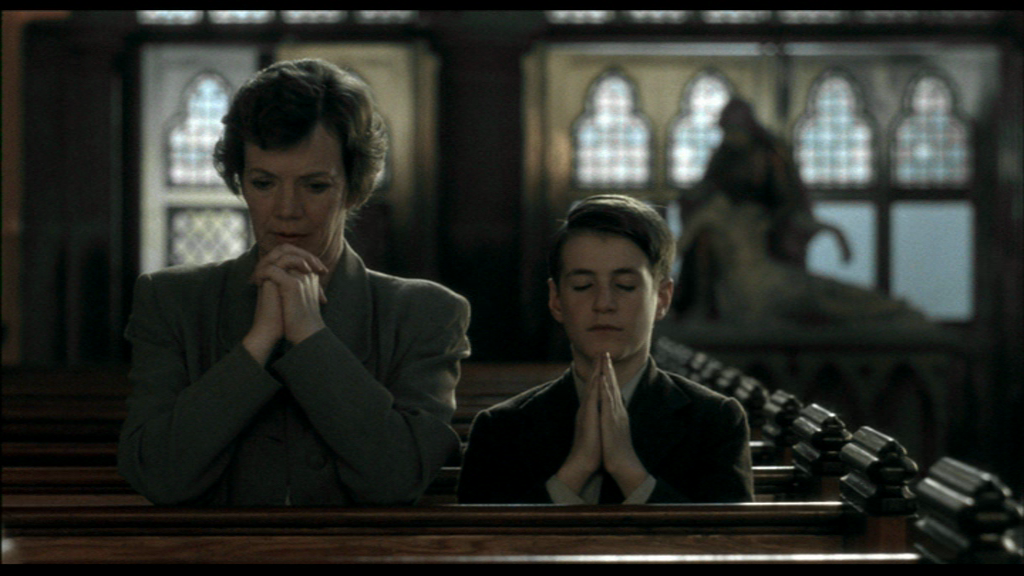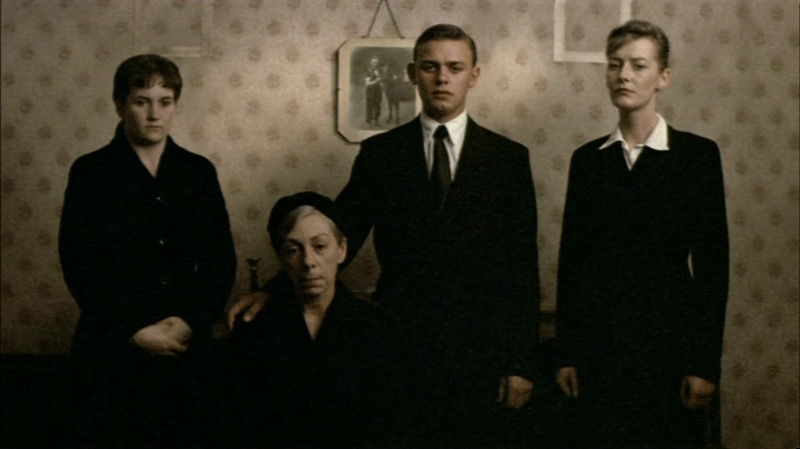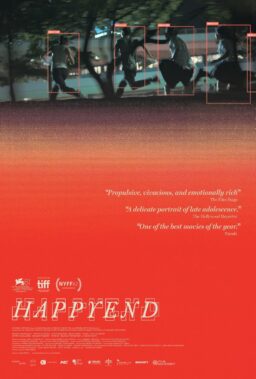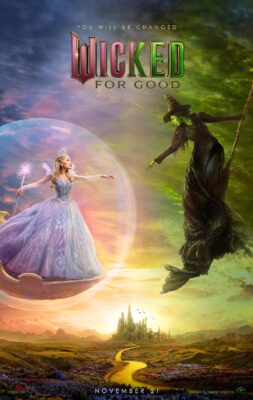Editors’ Note: Liverpool-born filmmaker Terence Davies has carved out one the most distinctively personal bodies of work in cinema. Mostly avoiding traditional storytelling structures, he favors tales that are driven by memory, fantasy and free-association, and that don’t look or move like any films before or since. Michael Koresky, the co-founder of the online film magazine Reverse Shot and the staff writer of the Criterion Collection, has published a new book with the University of Illinois Press that analyzes Davies’ themes and style, simply titled Terence Davies. We are pleased to offer an excerpt here.
Terence Davies’s cinema has defied easy
categorization from the very start. In fact, his first official feature can
hardly be termed a feature at all.
“The Terence Davies Trilogy,” as it was
called when released in 1984, is a compilation of three black-and-white shorts
shot on 16mm over the course of seven years—”Children” (1976), “Madonna
and Child” (1980), and “Death and Transfiguration” (1983)—all of which
evince compositional poise and thematic audacity. The most strongly
gay-oriented films of Davies’s career, these were made years before there was
anything approaching an alternative queer-cinema movement. The trilogy’s
importance to Davies’s artistic mission is solidified by his choice to further
explore its main character, milieu, theme, and tripartite structure in his only
novel, “Hallelujah Now” (1983), which similarly delves into its
protagonist’s profound guilt and trauma over his homosexuality in an
achronological, stream-of-conscious manner that effectively destabilizes the
present.
With his next two films, Davies continued to
excavate his past, breaking up time in even more radical ways. “Distant
Voices, Still Lives” (1988) and “The Long Day Closes” (1992), companion
pieces of a sort, and the works on which the director’s reputation largely
lies, are woven tapestries of sounds and images, dreams and desires of a
specifically working-class milieu that both evoke and fly in the face of the
British school of realism that defined Davies’s national cinema, from John
Grierson and Humphrey Jennings’s groundbreaking experiments in documentary in
the 1930s and 1940s to the “kitchen-sink dramas” of the 1950s and 1960s to the
“heritage” and new-realist films of the 1980s and 1990s, typified by
Merchant-Ivory and Mike Leigh, respectively.

While Davies adheres to a certain
verisimilitude in his direction of actors in these films, his stylized
cinematography and radical, dreamlike editing helps them dispense with the
realism audiences would come to expect. In their clear move away from these
traditions, “Distant Voices, Still Lives” and “The Long Day Closes” captured
the attention and admiration of the British
film community; their unorthodox aesthetic techniques were acknowledged as
evidence of a singular artistic voice, but at the same time, their
autobiographical nature led many critics to pigeonhole Davies as a filmmaker
interested strictly in his own past, a charge that would prove increasingly
false as his career unfolded.
“Distant Voices, Still Lives” is
aesthetically distinguished by two radical choices that set it dramatically
apart from other family-memory films of the era (John Boorman’s “Hope and
Glory” [1987] is an excellent concurrent example in the United Kingdom;
while Ettore Scola’s “The Family” [1987] and Barry Levinson’s “Avalon” [1990]
make for more sentimental evocations of similar themes of generational loss
from other countries, Italy and the United States, respectively.)
The first is
its expressive camera technique, which is made up of many static tableau-like
compositions, punctuated by elegant tracking shots, the combination of which
creates a dreamlike space that hangs somewhere between the authentic and the
artificial. This almost constant negotiation of verisimilitude and
constructedness heightens the viewer’s sense that he or she is taking part in
the filmmaker’s subjective truth, a version of a reality affected by the
magnifications and alterations of memory, whether idealized or deprecated.
The second way Davies’s film represents a radical
move away from traditional forms of fictional narrative is in its use of music.
The whole of “Distant Voices, Still Lives” is constructed of seemingly
disconnected scenes, threaded together by a complex series of voiceovers,
popular songs and religious hymns, and, occasionally, synched dialogue that is
used to sound-bridge disparate spaces. The most memorable sounds that bring
together the film’s many shards as well as create a more thematic harmony,
however, are the popular radio tunes or ditties sung on-camera by its many
characters. Entire sequences are made up strictly of these songs, whether
performed as solos or singalongs, in the family’s parlor or in the neighborhood
pub.

Similarly revealing the specters of the director’s haunted childhood via a
collage-like conglomeration of memories and pop-cultural references, “The
Long Day Closes” brought Davies himself back into the equation. Front and
center is Bud, a dour-faced boy on the verge of a puberty all the more
traumatic for the explosion of homosexual desire that comes with it; unlike “Distant
Voices, Still Lives“, in which the past is a malleable compound made up of
the perspectives of multiple characters, this film emanates from a single
consciousness.
The evolution of Davies’s career up to this point
would make one wonder whether fragmented memories were all he was capable of
summoning. His next film, though a wild departure in many ways, did not provide
easy answers. “The Neon Bible” (1995), adapted from John Kennedy Toole’s
slim bildungsroman about a sensitive boy’s coming-of-age in the deep American
South, represented a striking change of milieu for Davies, yet many of the
director’s already established hallmarks were in full view: taciturn young male
protagonist, colorful and more outspoken older relative, the tyrannies of
bullies and teachers, the comfort of movies, the birth of religious skepticism.
If this alien landscape introduced a new (and probably healthy) awkwardness in
Davies’s filmmaking, it also resulted in a singular hybrid of Davies’s poetic
British lyricism and stoic American gothic. Davies’s long, steady tracking shots
and unbroken single takes register as dissociated and surreal when reconfigured
into a Georgia-shot tale that features one character’s dramatic descent into
madness and another’s violent, climactic killing.
The Neon Bible met with a cool response
from critics and audiences; his next project brought him further from the
well-trod territory of the memory film, and fully into the warm embrace of the
cinematic community. “The House of Mirth” (2000), his pristine and
chilling adaptation of Edith Wharton’s first novel, set in a viperous,
upper-class, turn-of-the-century New York City, features his most atypical
subject matter thus far. “The House of Mirth” is an undeniable, elegant
triumph in terms of storytelling, performance, and imagery. Yet the film’s
sheen of decorum masks what is essentially a horror movie, albeit one in which
words are swiftly and efficiently used as deadly weapons, and in which the
moral righteousness of its tragic heroine accelerates her downfall.
By the time
he made The House of Mirth, Davies was so known for these experiments in
memory that, as he said, “I wanted to prove that I could write a linear
narrative in which you seed things that pay off.” Not only is the film’s narrative told in a linear fashion, it moves forward
with a scary inexorability, one scene following another with brutally gradual
momentum. As in Davies’s childhood films, there seems to be an almost constant
fear (of being rejected, of being found out) simmering beneath “The House of Mirth”.
Whereas “The House of Mirth” is a remarkably
faithful adaptation of Wharton’s book, in which most noticeable alterations
(the amalgamation of two supporting characters for dramatic economy, the
excising of a small climactic scene) were ultimately slight, “The Deep Blue
Sea” is a dramatic rethinking of Terence Rattigan’s play, maintaining its
basic structural through-line but using it as a foundation for experiments
in cinematic time and memory. That “The Deep Blue Sea” diverges so much
from the original Rattigan text is particularly surprising in light of the fact
that the project was developed with funding from the Sir Terence Rattigan
Charitable Trust on the occasion of the playwright’s centenary.
Yet with carte
blanche from producers to take liberties in his adaptation (“The Rattigan Trust
told me after I’d done a tentative first draft, ‘Be radical!’ So I was,” he
told Geoff Andrew in Sight & Sound), Davies made a film that
could be called a re-imagining of the source text. “The Deep Blue Sea” is
thus wholly unorthodox as a tribute, yet in its fidelity to both Rattigan’s
spirit and to Davies’s integrity (the director found much in the original play
either implausible or uncinematic), it is perhaps the most expressive and
cohesive film based on a Rattigan play. Furthermore, Davies’s artistic
sensibilities accentuate the implicit queerness in the original work; when
paired with ‘The House of Mirth’’s Lily, ‘The Deep Blue Sea’’s Hester
seems all the more fascinating as a source of queer identification.

Before he made “The Deep Blue Sea,” Davies
embarked on a film that is singular in his oeuvre while at the same time
furthers many ideas present in his other works. “Of Time and the City” (2008),
Davies’s single nonfiction film as well as his only one partially shot and
edited on digital video, was made as part of a micro-budget initiative called
Digital Departures. Commissioned as a work of historical documentary for the
city of Liverpool (the initiative was partly backed by the Liverpool Culture
Company), Davies’s film, unsurprisingly, turned out to be something far more
personal—and critical—than a simple tribute; instead he created a patchwork of
intimate revelations and reminiscences that are crosshatched with a wider
historical and sociopolitical interrogation of Liverpool, from the 1950s of his
childhood to the city as it stands in the first decade of the twenty-first
century.
Davies’s take on Liverpool is subjective—it’s an untenable place of
the mind that exists even more vividly in his recollections than in the
preexisting stock footage that makes up most of the film’s visuals. “Of Time
and the City” is bracing in its rejection of several common documentary
practices, eschewing impersonal third-person narration in favor of Davies’s own poignant
tones (alternately honeyed and barbed-tongued) and refusing to contextualize or
identify much of what we see via onscreen text or more direct voice-over. Thus
even Davies’s seemingly simple pocket-sized tribute to the hometown of his lost
childhood becomes a highly complex, unorthodox work of nonfiction, in which one
man’s experience of his city’s changing landscape is inextricable from the
shame he felt over his own sexual coming-of-age or the joy he receives from
recalling certain songs or movies—in other words, Davies’s sense memory here
becomes the memory of Liverpool.
Davies’s relatively small output for such a long
career is not by choice (for contrast, look at another filmmaker who’s worked
in the same basic stretch of years as Davies, the more commercial filmmaker
Neil Jordan, who managed to direct seventeen features between 1982 and 2012).
Funding for Davies’s films has been difficult to raise, and the director has
been notoriously outspoken on the subject, never shying away from denouncing
the state of the contemporary British film industry following the government’s
destruction of the British Film Institute Production Board (“Now if a young
filmmaker wants to use cinema as a form of expression and an art form, where do
they go? How do they get it off the ground?” he asked in a 2006 interview with The
Guardian) and bemoaning his outsider status
within it.
The eight years between “The House of Mirth” and “Of Time and
the City” constituted Davies’s most prolonged, sharply felt absence from the
film scene, even though “Mirth”’s major critical and commercial success
seemed to indicate that new doors would open for him. Instead, one project
after another fell through, including a romantic comedy titled “Mad about the
Boy” and adaptations of the books “Sunset Song” by Lewis Grassic Gibbon
(which Davies hoped would be heading into preproduction at the time of this
writing) and “He Who Hesitates” by Ed McBain. Unlike “The Trilogy,”
“Distant Voices, Still Lives,” “The Long Day Closes,” “The Neon Bible,” and “The
House of Mirth,” all of which were projects he shepherded from the outset, “The
Deep Blue Sea” and “Of Time and the City” were suggested to him by
others. This ultimately doesn’t make them any less personal, but it does give
us a sense of the difficulties Davies has had in getting his own projects made
and how important it has been in the current state of the industry, so focused
on the box-office bottom line, for him to take advantage of such opportunities.
That Davies continues to have these sorts of
struggles is perhaps in keeping with an artist who prevails despite, or indeed
because of, emotional setbacks. “Without all that suffering, there wouldn’t
have been any films,” he said in a 1992 interview. The beauty that
emerges from such pain reveals a method of re-appropriating the past that we
might call “queer” in the way it reconstitutes shards of Davies’s cultural and
familial detritus into new forms. That his art is empowering in its expression
of sexual and social difference and at the same time stuck in a mode one could
associate with victimization helps define the central contradictions that fuel
Davies’s cinema.
From Terence Davies by Michael Koresky.
Copyright 2014 by the Board of Trustees of the University of Illinois.
Used with permission of the University of Illinois Press.












